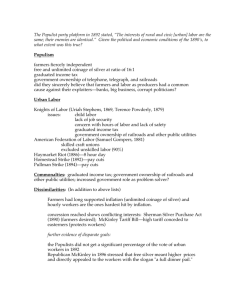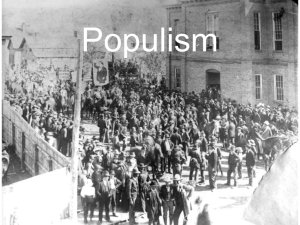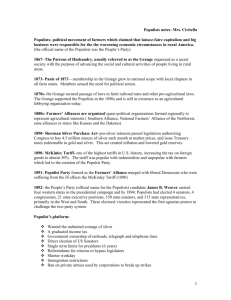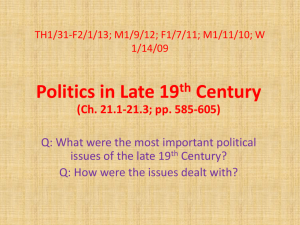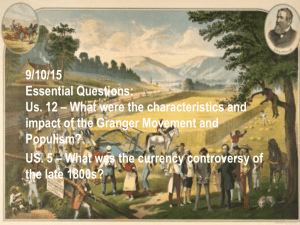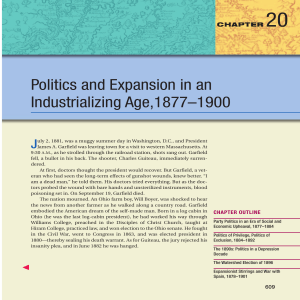1285430840_410494
advertisement
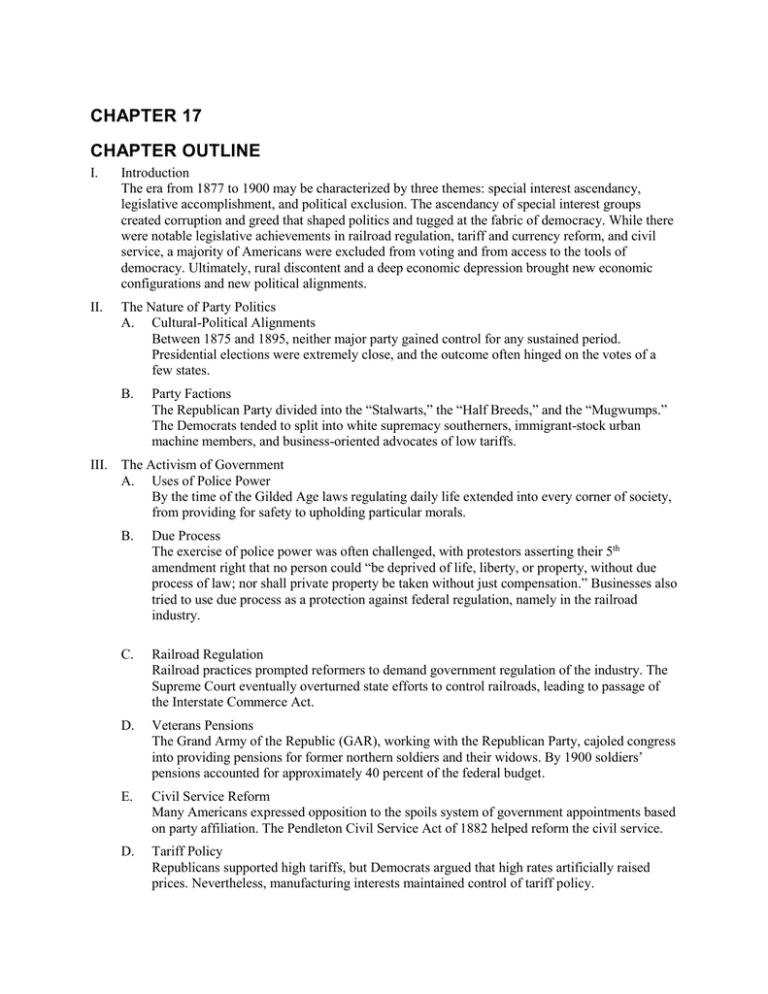
CHAPTER 17 CHAPTER OUTLINE I. Introduction The era from 1877 to 1900 may be characterized by three themes: special interest ascendancy, legislative accomplishment, and political exclusion. The ascendancy of special interest groups created corruption and greed that shaped politics and tugged at the fabric of democracy. While there were notable legislative achievements in railroad regulation, tariff and currency reform, and civil service, a majority of Americans were excluded from voting and from access to the tools of democracy. Ultimately, rural discontent and a deep economic depression brought new economic configurations and new political alignments. II. The Nature of Party Politics A. Cultural-Political Alignments Between 1875 and 1895, neither major party gained control for any sustained period. Presidential elections were extremely close, and the outcome often hinged on the votes of a few states. B. Party Factions The Republican Party divided into the “Stalwarts,” the “Half Breeds,” and the “Mugwumps.” The Democrats tended to split into white supremacy southerners, immigrant-stock urban machine members, and business-oriented advocates of low tariffs. III. The Activism of Government A. Uses of Police Power By the time of the Gilded Age laws regulating daily life extended into every corner of society, from providing for safety to upholding particular morals. B. Due Process The exercise of police power was often challenged, with protestors asserting their 5th amendment right that no person could “be deprived of life, liberty, or property, without due process of law; nor shall private property be taken without just compensation.” Businesses also tried to use due process as a protection against federal regulation, namely in the railroad industry. C. Railroad Regulation Railroad practices prompted reformers to demand government regulation of the industry. The Supreme Court eventually overturned state efforts to control railroads, leading to passage of the Interstate Commerce Act. D. Veterans Pensions The Grand Army of the Republic (GAR), working with the Republican Party, cajoled congress into providing pensions for former northern soldiers and their widows. By 1900 soldiers’ pensions accounted for approximately 40 percent of the federal budget. E. Civil Service Reform Many Americans expressed opposition to the spoils system of government appointments based on party affiliation. The Pendleton Civil Service Act of 1882 helped reform the civil service. D. Tariff Policy Republicans supported high tariffs, but Democrats argued that high rates artificially raised prices. Nevertheless, manufacturing interests maintained control of tariff policy. E. Monetary Policy Farmers favored the coinage of silver to increase the amount of currency in circulation. Creditors favored a limited money supply, based on the gold standard. This issue shaped political fights throughout the era. F. Legislative Accomplishments The amount of legislation passed is surprising and included laws strengthening the government’s influence in the national economy. IV. Presidential Initiative A. Hayes, Garfield, and Arthur The presidents from 1877 to 1890 proved to be less forceful than their predecessors. B. V. Cleveland and Harrison Grover Cleveland became the first Democratic president since James Buchanan. He used the veto extensively, promoted merit-based civil service, and urged tariff reform. Benjamin Harrison had a Republican majority in Congress, but he alienated many of his supporters. In Cleveland’s second term, the president proved unable to resolve the crises he faced. Discrimination and Disfranchisement A. Violence Against African Americans Black southerners endured economic and political oppression, and they often suffered the extreme violence characterized by lynching. B. Disfranchisement White southern politicians sought to limit African American access to the polls through such measures as the poll tax, literacy tests, and the “grandfather clause.” As a result, African Americans in the South had effectively been disfranchised by the 1900s. C. Legal Segregation With the Supreme Court’s decision in the Civil Rights cases of 1883, the South began to institutionalize racism and segregation through the passage of Jim Crow laws. Such laws were upheld by the Court in Plessy v. Ferguson. In 1899, the Court applied the “separate but equal” doctrine to schools in Cummins v. County Board of Education. D. African American Activism African Americans challenged the discriminatory political climate in a variety of ways. E. Woman Suffrage The woman suffrage movement split into two groups. The National Woman Suffrage Association advocated women’s rights through a constitutional amendment and fought for suffrage on a national level. The American Woman Suffrage Association worked for suffrage on the state level. VI. Agrarian Unrest and Populism A. Hardship in the Midwest and West Midwestern farmers experienced falling prices for staple crops while expenses remained high. Western farmers and miners suffered due to railroad monopolies. B. Grange Movement As agricultural prices dropped, farmers organized. Oliver H. Kelley helped start the Grange movement, but in the late 1870s, its influence declined significantly. C. The White Hats In the Southwest, Hispanics organized a group known as the White Hats to counter the movement of English-speaking ranchers into communal pastureland. D Farmers’ Alliances The Farmers’ Alliances constituted a genuine mass movement by 1890. Alliances sponsored political rallies, educational meetings, and cooperative marketing agreements. The Alliances proposed the subtreasury plan, in effect a federally sponsored subsidy program, to relieve shortages of cash and credit. E. Problems in Achieving Alliance Unity As a result of racism and sectional differences, the different Alliance groups could not unite, so they failed to bring about any change. F. Rise of Populism In 1890, the Kansas Alliance held a “convention of the People” that formed the People’s Party. In 1892, the People’s Party, or Populists, developed a comprehensive platform addressing the needs of farmers and laborers. G. Populist Spokespeople The Populist campaign produced dynamic personalities who often used political language that was stirring and often blunt and inflammatory. VII. The Depression and Protests of the 1890s A. Continuing Currency Problems The Panic of 1893 made the currency issue critical. Congress repealed the Sherman Silver Purchase Act in 1893, and President Cleveland finally had to accept an offer of gold from J.P. Morgan to stem the run on the United States Treasury. B. Consequences of Depression The depression hastened the demise of the old economic system and the emergence of a new one. The depression became widespread because the economic system had become national rather than regional. American farmers now had to respond to a new global marketplace. C. Depression-Era Protests The emergence of new corporate institutions widened the gap between employers and employees. This led to the railroad strikes of 1877, the Haymarket riot of 1886, a general strike in New Orleans in 1891, violence at the Coeur d’Alene silver mine in 1892, and the Homestead strike in 1892. When the economy plunged into recession in 1894, there were over 1,300 strikes. D. Socialists With the depression of the 1890s, some workers became socialists. E. Eugene V. Debs The Pullman Strike in 1894 elevated Eugene V. Debs to a position of leadership within the socialist movement. F. Coxey’s Army Jacob Coxey urged the government to issue unbacked paper money to stimulate spending. His “army” of unemployed workers numbered five hundred when it reached Washington, D.C., on April 30, 1894. Congress refused to respond, and the police crushed the protest. VIII. The Silver Crusade and the Election of 1896 A. Free Silver By 1896, the Populists made the free coinage of silver their primary issue. They believed that such a policy would end the privileged position of the rich. As a third party, the Populist Party encountered roadblocks. B. Nomination of McKinley William McKinley headed a Republican party that supported the gold standard. C. William Jennings Bryan The Democrats chose William Jennings Bryan to head their ticket for free silver. The Populists also nominated Bryan. D. Election Results McKinley won the election in the most lopsided victory since 1872. Free silver did not provide the reform issue that would unite the masses. E. The McKinley Presidency McKinley signed the Gold Standard Act in 1900, oversaw an increase in tariff rates, and encouraged imperialistic ventures in Latin America and the Pacific.

